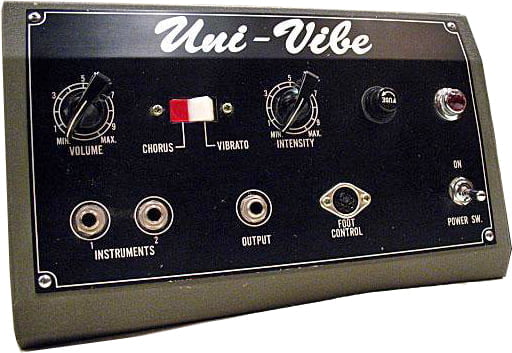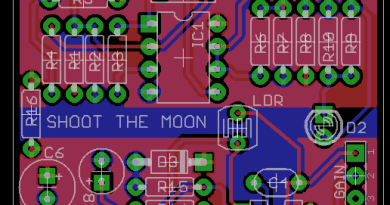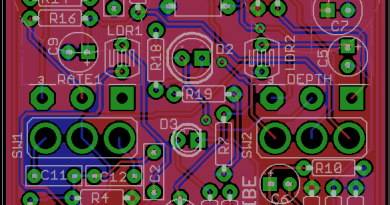Is the Univibe a Phaser?
There have been many an online (and offline) argument about the nature of the classic Univibe pedal. Is the Univibe a phaser? Is it a vibrato? Or is it something in between or something altogether different?
Is the Univibe a Phaser: The Short Answer
In the most pure sense of the question, the answer is an emphatic YES. The Univibe sound is built on four phase-shift stages that are modulated by a low-frequency oscillator. In this sense, it’s similar to the MXR Phase 90, which is also a four-stage phaser. So the answer is that Univibe is a phaser, and that’s the end of it, right? Well, not quite. 🙂
Is the Univibe a Phaser: The Long Answer
So yeah, the Univibe is a phase shifter at its core. But here are the main ways in which it is actually rather divergent from the the typical phase shifter circuit:
Optical vs FET Variable Resistance
One of the primary differences between the Univibe and the Phase 90 is how each implements the variable resistance elements that are necessary for the LFO to act upon and create that great filter-sweep sound. The Univibe uses four light-dependent resistors (LDRs) that are modulated by a small incandescent bulb that is driven by a low-frequency oscillator. When the bulb is bright, the LDRs have low resistance, and when it is dark, the LDRs have high resistance. LDRs do not behave strictly linearly, so the rise and fall in resistance is not at the same speed. This lends an asymmetric sound to the modulation, which some people describe as “throbby” or “choppy”, and this sound is a big part of what makes the Univibe sound so unique. Examples: Jimi Hendrix, Robin Trower, and Govt Mule (to name just a few of many).
This throbby sound lends a bit of tremolo sound as well, and the clean signal passthrough creates some filter-sweep classic phaser tones riding on top of the pitch bend generated by the phase shifted wet signal. So you sort of get vibrato, phase, and tremolo all in one with the Univibe, especially with the LFO depth set high.
On the other hand, the Phase 90 uses JFET transistors configured as voltage-controlled variable resistors. In this role, JFETs do behave quite linearly, and the resulting phasery sweep is a lot more smooth sounding than the Univibe. A great example of this type of phasing can be heard on Pink Floyd’s “Breathe” from Dark Side of the Moon. Gilmour was using a Phase 45 on that track, but the smooth filter-phase sound is the same.
Transistors vs Operational Amplifiers / LFO
A secondary difference is the use of transistors in the Univibe, versus using op amps in the Phase 90. For the audio signal path, there’s not much difference between the two, but when it comes to the LFO, there’s quite a difference. On the Univibe, the LFO is set up to produce a sawtooth-like waveform, whereas the Phase 90’s op amp LFO produces a triangle wave shape. The non-linear LFO wave of the Univibe, combined with it’s non-linear behaving LDRs combine to accentuate the “throbby” asymmetric character that people love (or hate).
Vibe vs Vibrato
There is a lot of confusion around the terms “vibe” and “vibrato”. They are often used interchangeably, but generally in the world of guitar effects, these are two different basic circuit types.
Vibe generally means circuits like the Univibe that contain elements of pitch vibrato, phasing, and often some tremolo-like sounds all rolled into one. These are basically phasers at their core, as phase shifting introduces some pitch bending (which is audible when the dry signal is either partially or totally removed).
Vibrato, on the other hand, typically refers to a BBD-based time delay effect that has a deep pitch bend and does not have any phasing/filter effects or tremolo-like sounds. A classic commercial example is the Boss VB-2, the Diamond Vibrato, the Zvex Instant Lofi Junkie, and the TC Electronics Tailspin. Often these circuits are referred to as “true vibrato” to differentiate them from Univibe-like circuits. Most used BBDs for the time delay, but some also use digital applications for the pitch shifting.
Disclaimer: some links on this page may be affiliate links.
For Further Reading
If you’d like to go “down the rabbit hole” a bit more how how phasers and Univibes work, here’s a list of resources to get your started:
Phaser Pedal Types – Function f(x) Pedals
The Technology of the Univibe – GeoFex
Univibe 101 – JHS Pedals
You may also be interested in How BBDs Work (in an analog delay).




